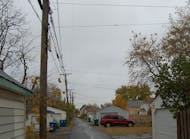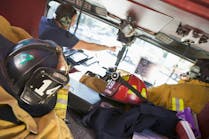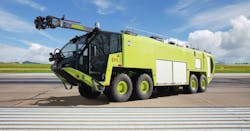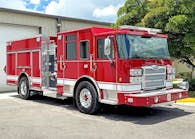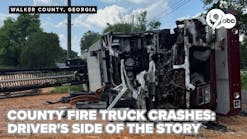We just had an interesting training night at the local firehouse. The usual 15 or so firefighters and officers were there and although a training topic scheduled, we tried something different. The firefighters were all asked to gather around the 1980s-vintage rear-mount aerial ladder. We started at the first compartment on the driver’s side just behind the crew compartment and the question was asked, “What is in this compartment?” The question was not just thrown out to the group, but rather a single firefighter was put on the spot.
We asked just one firefighter, rather than the group, because it puts some pressure on that single member. Sure, the other firefighters were straining to remember just what is in there too, but they didn’t have to answer. Not just yet.
A wake-up call
The first firefighter named a tool that he believed was in that compartment. So we opened the compartment and, sure enough, that tool was right there on the top shelf. We quickly closed the compartment and asked another firefighter what else is in there. That firefighter also gave a correct answer and named one of the other items in the compartment. As we went through each of the truck’s compartments, we continued to ask the question to another and another and another firefighter.
Some of the firefighters had the answer every time, even when the question was being asked of other members. Others were not quite sure, but they had an idea about what tools are carried on the rig.
The process of going through what may be viewed as familiar material was a great lesson in training and familiarity. Most of the firefighters who were at that drill attend almost every drill. They are frequent responders and good attentive firefighters. What was surprising was that there were tools and other pieces of equipment in just about every compartment that almost none of the members in attendance knew about. This is not a criticism, but rather a wake-up call. We all get into a regular routine at the firehouse, whether you are a career firefighter who follows the same rig-check routine every shift or a volunteer who goes through the apparatus compartments during the weekly rig check. Let’s take a look at a great way to conduct a tool-and-equipment check on your apparatus;
First, select a compartment. Before opening it, name the tools and equipment inside. Not just the major tools, but all of the associated items. If the compartment holds the portable power saw, that’s great. If there is one circular saw and one chain saw, you must know that too. You need to also know that there is a fuel tank to refuel the two saws. You must know what type of fuel or fuel mix is in each fuel tank and which saw takes which fuel. If the tools to remove the blade are stored here, you need to know that, and how to use them. If spare blades or chains are inside, that too must be known.
Second, when you identify each tool or piece of equipment, remove it from the compartment and examine it. Make sure it is in good shape. Ask questions about each piece. If you have a collection of hand tools, ask about each one. What is the pike axe best used for? Can it be used for forcible entry? Is the blade sharp or nicked and dull? Is the handle tight and smooth? When you look at the power saw blades, have the firefighters identify each blade and tell what it is used to cut. How many tips missing from a carbide tipped blade should cause it to be taken out of service and replaced? Do you fully throttle up the circular saw when cutting with the carbide-tipped blade? Is the same process used for the metal cutting blade?
Third, remove and start any tool or piece of equipment that uses a motor. The starting procedure should be reviewed before attempting to start the motor. Remove carry slings and other attachments before starting the motor. Use ear and eye protection during this check, just as you would during operations. Ask the firefighters how you can tell by simply looking at a machine whether it uses straight (only) gasoline or a gasoline-oil mixture. Once that is determined, make sure the proper fuel tank is located and also that it is properly labeled as “gas” or “gas/oil mix,” or maybe labeled with the name of the machine that it refuels.
This simple process can be used as a training session or used by the firefighters who are checking each rig. The process can be modified or streamlined to fit your department’s needs, but the value is obvious. Make sure you can answer the question, “What’s on that rig?”
JOHN J. SALKA Jr., a Firehouse® contributing editor, recently retired as a battalion chief with FDNY, serving as commander of the 18th battalion in theBronx. Salka has instructed at several FDNY training programs, including the department’sProbationaryFirefightersSchool, Captains Management Program and Battalion Chiefs Command Course. He conducts training programs at national and local conferences and has been recognized for his firefighter survival course “Get Out Alive.” Salka co-authored the FDNY Engine Company Operations manual and wrote the book First In, Last Out – Leadership Lessons From the New York Fire Department. He also operates Fire Command Training (www.firecommandtraining.com), a New York-based fire service training and consulting firm.
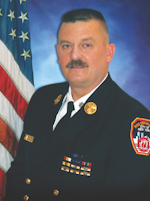
John J. Salka Jr. | Battalion Chief
JOHN J. SALKA JR., who is a Firehouse contributing editor, retired as a battalion chief with FDNY, serving as commander of the 18th battalion in the Bronx. Salka has instructed at several FDNY training programs, including the department’s Probationary Firefighters School, Captains Management Program and Battalion Chiefs Command Course. He conducts training programs at national and local conferences and has been recognized for his firefighter survival course, “Get Out Alive.” Salka co-authored the FDNY Engine Company Operations manual and wrote the book "First In, Last Out–Leadership Lessons From the New York Fire Department." He also operates Fire Command Training, which is a New York-based fire service training and consulting firm.

